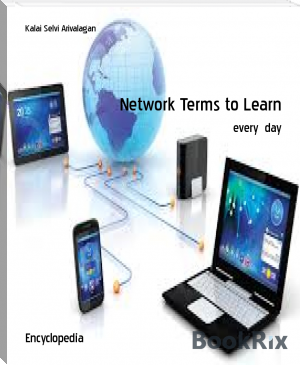Network Terms to Learn - Kalai Selvi Arivalagan (best love novels of all time .TXT) 📗

- Author: Kalai Selvi Arivalagan
Book online «Network Terms to Learn - Kalai Selvi Arivalagan (best love novels of all time .TXT) 📗». Author Kalai Selvi Arivalagan
Data Management
Data management refers to an organization's management of information and data for secure and structured access and storage. Data management tasks include the creation of data governance policies, analysis and architecture; database management system (DMS) integration; data security and data source identification, segregation and storage.
Oracle Database (Oracle DB)
Oracle Database (Oracle DB) is a relational database management system (RDBMS) from Oracle Corporation. Originally developed in 1977 by Lawrence Ellison and other developers, Oracle DB is one of the most trusted and widely used relational database engines for storing, organizing and retrieving data by type while still maintaining relationships between the various types. The system is built around a relational database framework in which data objects may be directly accessed by users (or an application front end) through structured query language (SQL). Oracle is a fully scalable relational database architecture and is often used by global enterprises which manage and process data across wide and local area networks. The Oracle database has its own network component to allow communications across networks. Oracle DB is also known as Oracle RDBMS and, sometimes, simply as Oracle.
Oracle Public Cloud
The Oracle Public Cloud is an application development platform solutions delivered entirely through the Internet on a subscription-based billing method from Oracle Corporation. Oracle's public cloud solution provides enterprise-class applications, middleware services and databases managed, hosted, patched and supported by Oracle itself. The services offered under Oracle public cloud are, Fusion CRM and HCM Cloud, Social Network Cloud, Database Cloud and Java Cloud and being hosted at Oracle's datacenters by default, posses a scalable, flexible and secure architecture.
Data Preprocessing
Data preprocessing involves transforming raw data to well-formed data sets so that data mining analytics can be applied. Raw data is often incomplete and has inconsistent formatting. The adequacy or inadequacy of data preparation has a direct correlation with the success of any project that involve data analyics. Preprocessing involves both data validation and data imputation. The goal of data validation is to assess whether the data in question is both complete and accurate. The goal of data imputation is to correct errors and input missing values -- either manually or automatically through business process automation (BPA) programming.
Data preprocessing is used in both database-driven and rules-based applications. In machine learning (ML) processes, data preprocessing is critical for ensuring large datasets are formatted in such a way that the data they contain can be interpreted and parsed by learning algorithms.
Term of the day - 26
Enterprise Knowledge Management (EKM)
Enterprise knowledge management (EKM) is a fairly broad term in IT that refers to any solutions or systems that deal with organizing data into structures that build knowledge within a business. Another way to say this is that knowledge management solutions create business knowledge out of existing assets.
Nonprofits and businesses often create knowledge management departments or structures that help to oversee business processes and to order intangibles such as data assets. This fits into a bigger picture of enterprise resource planning and business intelligence, where many different kinds of software assist human decision-makers in making the most informed decisions based on a large field of existing data.
Knowledge Representation
The field of knowledge representation involves considering artificial intelligence and how it presents some sort of knowledge, usually regarding a closed system. IT professionals and others may monitor and evaluate an artificial intelligence system to get a better idea of its simulation of human knowledge, or its role in presenting the data about focus input.
Active Threat Management
In IT, active threat management means working proactively to defend networks and systems against active threats. The term creates confusion because it is so commonly used in the field of physical security against an active threat, such as an active shooter. In IT, active threat management can mean managing an active threat, or taking an approach to threat management that is active.
Low-Code/No-Code Development (LCNC Development)
Low-code/no-code (LCNC) development refers to an environment where visual drag-and-drop applications or similar tools allow individuals and teams to program applications without a lot of linear coding. These types of systems help the IT world to deal with a lack of skilled developers and streamline the emergence of new applications and interfaces.
Industrial Internet of Things
The industrial internet of things (IIoT) is a term for all of the various sets of hardware pieces that work together through internet of things connectivity to help enhance manufacturing and industrial processes. When people talk about the industrial internet of things, they're talking about all of the sensors, devices and machines that contribute to physical business processes in industrial settings. By contrast, when people talk about the internet of things in general, they're talking about any connected devices that fit the IoT model. For instance, when people think about the internet of things, they often think about smart home devices that are linked together to provide consumer conveniences.
Pandas
Pandas is a library kit for the Python programming language that can help manipulate data tables or other key tasks in this type of object-oriented programming environment. Pandas may be useful in the design of certain machine learning and neural network projects or other major innovations where the Python programming language plays a role.
Deepfake
Deepfake is a term for videos and presentations enhanced by artificial intelligence and other modern technology to present falsified results. One of the best examples of deepfakes involves the use of image processing to produce video of celebrities, politicians or others saying or doing things that they never actually said or did.
Virtual Disaster Recovery
Virtual disaster recovery is a combination of storage and server virtualization that helps to create more effective means of disaster recovery and backup.
It is now popular in many enterprise systems because of the many ways that it helps to mitigate risk.
Data Exhaust
Data exhaust refers to the data generated as trails or information byproducts resulting from all digital or online activities. These consist of storable choices, actions and preferences such as log files, cookies, temporary files and even information that is generated for every process or transaction done digitally. This data can be very revealing about an individual, so it is very valuable to researchers and especially to marketers and business entities.
Intelligent Edge
Intelligent edge is a term describing a process where data is analyzed and aggregated in a spot close to where it is captured in a network. The intelligent edge, also described as “intelligence at the edge,” has important ramifications for distributed networks including the internet of things (IoT).
Document Object Model
Document Object Model (DOM) is a language and platform-independent convention that represents the interaction of objects written in markup languages, i.e., Hypertext Markup Language (HTML), Extensible Hypertext Markup Language (XHTML) and Extensible Markup Language (XML).
Cloud Orchestration
Cloud orchestration describes the arrangement of cloud automation processes to serve particular goals. Where cloud automation typically handles a single task, cloud orchestration helps to automate collections of tasks and generally streamline business processes.
Reality Distortion Field (RDF)
A reality distortion field (RDF) is a phenomenon in which an individual’s intellectual abilities, persuasion skills and persistence make other people believe in the possibility of achieving very difficult tasks. The term was coined by Apple employee Bud Tribble to describe former Apple Inc. co-founder, CEO and chairman Steve Jobs' ability to encourage his team to complete virtually any assigned or delegated task.
Virtual Telecommunication Access Method
Virtual Telecommunications Access Method (VTAM) is an IBM application programming interface that allows application programs to communicate or exchange data with external devices such as mainframes, communications controllers, terminals, etc. VTAM helps to abstract these devices into logical units so that developers do not need to know the underlying details of the protocols used by these devices.
Communication and Networking Riser (CNR)
A Communications and Networking Riser (CNR) is a riser card developed by Intel for the advanced technology extended (ATX) family of motherboards. It is used for specialized networking, audio and telephony equipment. When introduced, CNR offered savings to motherboard manufacturers by removing analog I/O components from the motherboard. While CNR slots were common on Pentium 4 motherboards, they have largely been phased out in favor of on-board or embedded components.
Master Data Management
Master data management (MDM) is the management of specific key data assets for a business or enterprise. MDM is part of data management as a whole, but is generally focused on the handling of higher level data elements, such as broader identity classifications of people, things, places and concepts.
Augmented Analytics
Augmented analytics refers to analytics processes that are enhanced by artificial intelligence (AI), machine learning (ML) and deep learning technologies. An important goal of augmented analytics is to allow non-technical line of business (LOB) professionals to write queries in plain English (instead of SQL) and make data-driven decisions without needing help from their organization's data scientists or machine learning engineers (MLEs). Augmented analytic is often a key competitive differentiator for self-service business intelligence (SSBI) platforms.
Wireless Charging
Wireless charging, also known as wireless power transfer (WPT), is the process of electrically charging battery-powered devices such as laptops, smartphones and electric vehicles without the need for a wired connection. Wireless charging can be enabled through three different forms.
Inductive Charging: Uses electromagnetic waves to transfer energy and charge devices wirelessly. Inductive charging requires the device to come in physical contact with a conductive charging pad that is directly connected to electrical power. Radio Charging: Similar to inductive charging, radio charging use wireless radio waves to transfer electricity. In this type of charging, the device sits on a transmitter that uses radio waves to charge the device.
Resonance Charging: Consists of a sending (sender) copper coil and a receiving (receiver) copper coil at the device end. When the sender and receiver are in close proximity and set to the same electronic magnetic frequency, electrical energy can be transferred. Resonance charging may also be referred to as over-the-air charging.
Software Bill of Materials (SBOM)
Software Bill of Materials (SBOM) is a document that provides details about the components used to build a software application. SBOMs are useful for identifying which software applications are most at risk when a third-party vulnerability is discovered.
SBOMs are created and maintained by software vendors and individual program authors. Ideally, a new SBOM should be created each time a new software verion is released to the general public. The documentation an SBOM provides can help stakeholders:
Gain better visibility into software assets. Conduct due diligence to assess risk. Identify and monitor potential regulatory compliance conflicts. Prioritize remediation options.
Continuous Delivery (CD)
Continuous delivery (CD) is a software development practice that automates quality assurance (QA) testing in order to facilitate frequent code releases to a staging server.
A continuous delivery approach requires the production and test environments to be similar. Once new code is committed, it triggers an automated work flow that builds, tests and stages the update. With continuous delivery, the developer makes the final decision about whether the code is stable enough to move into a live production environment, and the operations team is responsible for moving approved code from stage to a production server.
Vulnerability Management
Vulnerability management is a security practice specifically designed to proactively prevent the exploitation of IT vulnerabilities that could potentially harm a system or organization. The practice involves identifying, classifying, mitigating and fixing known vulnerabilities within a system. It is an integral part of computer and network security and plays an important role in IT risk management.
Phishing
Phishing is a security exploit in which a perpetrator impersonates a legitimate business or reputable person in order to acquire private and sensitive information, such as credit card numbers, personal identification numbers (PINs) and





Comments (0)